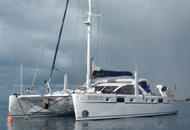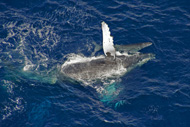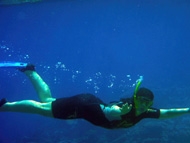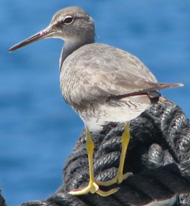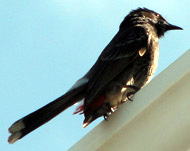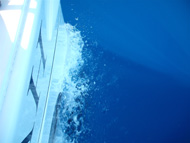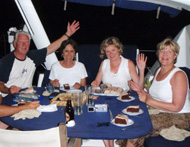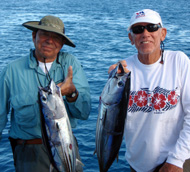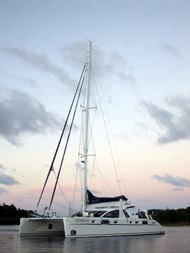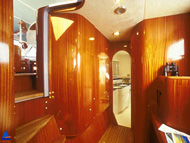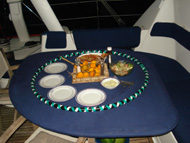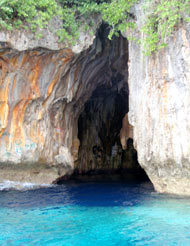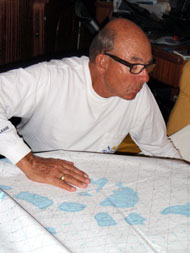 |
||||
 |
||||
 |
||||
Net Dynamic Menu by Vista-Buttons.com v4.3.0
We are listed on and
|
Sailing east from New ZealandorMethods of reaching points east from New ZealandBy: Scott Fratcher - Marine Engineer/Captain
Dozens of yachts will depart New Zealand each year with easterly destinations in mind. The persistent question will be how to make miles against the relentless south-east trade winds.
Sailing into the sunrise-Tahiti - This simple name conjures images of Captain Cook, green tropical paradise, and lazy islands in the sun. Often the dream fades when faced with the reality of a long upwind passage or a cold, storm ridden, southern latitude crossing.
In this article were going to discuss alternative routes to reach Tahiti from New Zealand.
The tricks presented in this article will help for all eastern destinations such as the Cooks, a return to the USA, or a local boat that wants to start at the top of the “ski slope”.
Eastward RoutesThis winter I was given command of a 58ft luxury Catamaran to sail around the Pacific as long as I could guarantee a reasonably quick, upwind delivery to Tahiti from New Zealand. Facing our passage options, I researched five possible routes to the Society Islands.
The five routes to Tahiti- 1. Depart New Zealand, drop to 40 degrees south and ride the westerlies.
Let’s discuss these routes in detail.
Standard route- Apx 2900 milesDepart New Zealand, drop to 40 degrees south and ride the westerlies till you can comfortably tack for Tahiti sailing the south east trades. This is the standard line given by pundits considering getting a boat to Tahiti. Let’s consider this route.
Disadvantage
* Storms- You can expect at least one deep low to pass the yacht, while many yachts suffer five or six batterings. Since this is a lonely section of ocean all repairs will have to be made onboard.
* Cold-The southern latitudes are cold. Cold is more than just an uncomfortable feeling, it affects the ability of the crew to respond to emergencies. As one boatie told me, “We sailed as far south as 42 degrees trying to find the westerlies, but my fingers became so cold and stiff I could no longer work the lines and had to turn north.”
* Westerlies?- The southern route expects the westerlies to fill in, but after talking to many boaties in Tahiti it seemed few actually found the downhill ride they were looking for. Every year is different, but many crews have reported persistent headwinds that made for a long slow passage.
* Cyclone Season- In order to reduce the chance of a southern ocean storm yachts are faced with a summer departure meaning a Tahiti arrival during cyclone season.
Advantage- * The number one reason to use the southerly route is the ability
to sail most of the route. For boats with small engines, (or simply
don’t want to burn fuel) this is the route of choice.
Auckland to Tahiti by the rhumline Apx 2200 milesThis route is similar to the southern route, but involves a motor-sail to the east directly from New Zealand. The idea is to use the south east winds to make a course of 60 true, sailing a tight reach directly to Tahiti.
Advantages * For boats that can make tight upwind progress this route offers
the shortest distance to Tahiti and can take advantage of the existing
south east winds.
Disadvantages * Few yachts can hold this course hard on the wind.
Tonga, Cooks, Tahiti- Aprox 2600 milesThis is often considered the most difficult of the possible Tahiti routes. The idea is to sail to Tonga and wait for a large low to pass south of the islands that effects, or reverses the trades. Statistically this happens about three times a year, but the odds can be increased if the yacht is willing to sail south to 25 degrees to ride the north side of a passing low.
Alternatively it may be possible to catch the approach of a high that causes the winds to shift south, south-east allowing the yacht to point directly at Tahiti on departure. When the winds fill in from the southeast it may be possible for the yacht to bare off for Bora,Bora.
Advantages * The least miles sailed
Disadvantages- * A long wait in Tonga
This route is generally considered the least desirable of the five passage options due to the high chance of encountering strong head winds in the lower trade wind latitudes. The saving grace is that the winds will often be from the south-east allowing a slant on the wind.
Tonga, Samoa, Suvorov, Tahiti- Aprox 2700 milesBetween Samoa and Tahiti often lies a slot of the lightest winds in the Pacific. This band is located the greatest distance from the north pacific high and the south pacific high often just out of reach of the effects of either. Frequently weeks go by with light and variable wind conditions meaning easy easterly progress by use of the motor.
SamoaSamoa is one of the best re-provisioning stops in the Pacific and the 1200 mile upwind leg to Bora Bora can be broken up with a stop at Suvorov (450 miles) and the possibility of an emergency anchorage at Mopelia (575 miles) or direct to Bora Bora (700 miles).
The weather plan is to use the “light” months (Jan-June) to make fast easterly progress on leaving Samoa. Depart Samoa when either “light and variable” or west winds are forecast. This wind condition occurs most often when a small low passes below Samoa. A gentle southerly wind left by the small low followed by light and variable winds is about perfect to make for an easy Suvorov landfall. Repeat the plan when sailing from Suvorov east.
Advantages- * Fast upwind passages possible by use of a strong motor.
Disadvantages- * The heat. This is a hot, sultry area of the ocean. Lack of trade
winds means long hot days cooking under intense sun. Sunshade is a must.
Tip-Diesel at the Samoa fuel docks is sold duty free. This equates to a one third discount from the land pump prices. The yacht must be brought to the fuel dock, normally used for ships. (Regulations prevent the filling of jury cans from a skiff) The fuel dock is protected by large black bumpers that leave black smears on a yachts gelcoat. At low tide the dock bumpers can be located over the rails of most yachts, so fill up at high tide with protection over the hull. Rags and thinners can help to remove the black marks.
Tip-Fuel up, and fill up. Don’t under estimate the amount of fuel a yacht can burn motoring upwind. If the trades fill in, or worse “re-enforced” trades (15-25 knots) fill in the ability to make the upwind landfall may come down to available fuel on board. Fill the tanks, and consider extra jury cans. Samoa is a consumers port and spare jury cans are available. Small barrels, restaurant cooking oil containers and commercial fuel jugs have all been used to temporarily hold extra fuel.
Tonga, Suvorov, Penrhyn, Tahiti (or Hawaii) Aprox 3300 milesThis is a classic route chosen by yachts with upwind sail ability attempting to return to the States from New Zealand. With a lucky south east wind much of this route can be sailed saving the fuel costs.
The Northern RouteSail for Tonga in the usual way. From Tonga sail upwind directly for Suvorov Island. This easily entered pass is a welcome break from the trades and provides the crew a comfortable station to wait for the next weather window. The trick is to wait for a south east slant on the wind.
Warning-Waiting for the trades to change direction can be frustrating, especially if the crew is in a hurry. The factors that change the trades are often determined by the position of the high passing to the south. This cycle can last a week or two at a time. Consider the wait carefully. A small amount of southerly wind in the trades can make a large difference in the yachts ability to make Penryhn island. The farther north a yacht sails the greater the chance of the winds turning dead east, thus easterly progress needs to be made early on this leg of the voyage.
Equatorial Counter CurrentThe equatorial counter current can be of use to boats destined for Hawaii or points farther east. Amazingly every year a few intrepid sailors reach destinations as far east as Panama from points as far west as New Caledonia by use of the Equatorial counter-current.
The Equatorial counter-current is a narrow band of current that travels eastward at speeds up to a knot and have been recorded by satellite at speeds over two knots. Considering the yacht is no longer pushing into a half knot of current this can mean a total perceived bonus of forty miles a day.
The Equatorial counter-current varies somewhere between 8 north and 5 south, but is predicted to lie about 5 north. Sailors find the counter-current by making the best course to an eastern destination while watching the Velocity Made Good (VMG) on the GPS. It’s important to continually monitor the VMG for a sudden positive jump. This tells the crew they have entered the narrow band of reverse current. From that point on the crew monitors the VMG and tacks through the counter current keeping careful note of the boundary, so if the current is lost the crew can make a prediction if a north or south course will re-locate the bonus miles.
Tip- Consider the boat’s propeller. Most yachts choose a propeller based on drag while sailing compared to thrust while motoring. The routes presented here are motor-sailing routes so purchasing a large, fixed blade, “power prop” designed to push you through the headwinds is called for. Keep the old prop and change back soon as your ready to sail again.
Tip- Pay careful attention to boat trim. Motor-sailing effectively through chop is much different than sailing through chop. Sufficient weight must be located forward to keep the bow down and force the yacht to “cut” through the wave. If the nose rises and presents the crafts underbelly to the oncoming sea she will surely be pushed a few meters backward on each wave no matter how much horsepower is applied to the prop.
Consider your boat’s propulsion-The northern routes are designed to take advantage of short weather windows. A beamy yacht with a small diesel will be severely limited in taking advantage of the options listed in this article. A yacht should be able to motor steady at six knots and seven is better. Remember there will be a half knot of current against you so a six knot boat is really only motoring east at a 120 mile a day. For low power boats consider motoring east from Samoa using a five day predicted calm to make as much easterly as possible. Use the calm to position the yacht for the predicted wind change.
Call now to book your luxury vacation
|
Articles originally published
in Sailing forum links |
|
||||
|
||||
| © Team Yachtwork 2009 |



